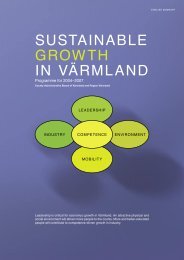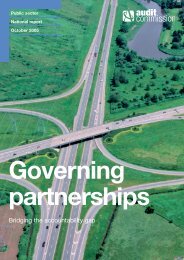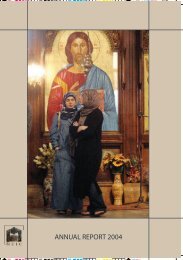successful partnerships a guide - Organisation for Economic Co ...
successful partnerships a guide - Organisation for Economic Co ...
successful partnerships a guide - Organisation for Economic Co ...
You also want an ePaper? Increase the reach of your titles
YUMPU automatically turns print PDFs into web optimized ePapers that Google loves.
<strong>successful</strong> <strong>partnerships</strong> a <strong>guide</strong><br />
16<br />
Some Thoughts about <strong>Co</strong>mmunication Techniques<br />
As <strong>partnerships</strong> are usually set up to find a better way to connect different policy areas and institutions<br />
working in those areas, the networking between these institutions and with their stakeholders is probably their<br />
most important task. “In<strong>for</strong>mal” ways of networking should be complemented by structured <strong>for</strong>ms of<br />
communication (websites, newsletters, etc.); this is especially useful in interaction with policy makers, opinion<br />
leaders, the general public and with other “outside” institutions with which the partnership interacts in the course<br />
of its work. One should there<strong>for</strong>e not overlook the importance of creating a stable in<strong>for</strong>mation flow and<br />
the necessity of tailoring it to the different target groups.<br />
Publicity materials may be needed in a variety of <strong>for</strong>mats, both web- and paper-based, to explain<br />
the concept of the partnership and its work. While the web enables a partnership to reach an unlimited number of<br />
people at comparatively low cost, handing out paper-based products is still considered more effective during<br />
public relation activities. The best solution is to combine methods, e.g. to have regular electronic newsletters and<br />
electronic as well as printed versions of annual reports, main results etc. Regular publication of reports on the<br />
work of the partnership and its successes (including evaluation reports) is essential both <strong>for</strong> the partnership’s<br />
visibility and <strong>for</strong> demonstrating the evidence basis <strong>for</strong> any recommendations the partnership makes (e.g. <strong>for</strong><br />
mainstreaming or <strong>for</strong> policy development). Seminars and conferences involving other practitioners and/or policy<br />
makers can be an effective means of disseminating in<strong>for</strong>mation about the partnership’s work and successes;<br />
they can also serve as tools <strong>for</strong> networking and opening debate about the direction of current and future<br />
activities.<br />
Special attention should be given to communication with local communities and target groups, as they<br />
represent the everyday environment of a partnership’s work and will, depending on their attitude towards<br />
the activities, support, tolerate or hinder that work. <strong>Co</strong>mmunication with them is there<strong>for</strong>e essential; it should not<br />
only provide them with a regular in<strong>for</strong>mation flow about the work and achievements, but also engage them<br />
and help create a feeling of ownership. The local communications strategy will there<strong>for</strong>e require a range<br />
of techniques, including close contact with local media, outreach facilities, newsletters, workshops or public<br />
meetings, audits of local resources and needs, etc. Venues and materials need to take account of accessibility<br />
issues to facilitate the participation of different target groups, such as the business community and marginalised<br />
groups.<br />
Marion Byrne<br />
Pobal (<strong>for</strong>merly Area Development Management Ltd), Ireland








